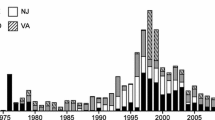Abstract
This paper explores the value of mangrove systems as a breeding and nursery habitat for off-shore fisheries, focusing on mangrove-shrimp production linkages in Campeche State, Mexico. We develop an open access fishery model to account explicitly for the effect of mangrove area on carrying capacity and thus production. From the long-run equilibrium conditions of the model we are able to establish the key parameters determining the comparative static effects of a change in mangrove area on this equilibrium. We then estimate empirically the effects of changes in mangrove area in the Laguna de Terminos on the production and value of shrimp harvests in Campeche over 1980–90. Our findings suggest that mangroves are an important and essential input into the Campeche shrimp fishery, but that the low levels of deforestation between 1980 and 1990 mean that the resulting losses to the shrimp fishery are still comparatively small. Over-exploitation of the fishery due to open access conditions remains the more pervasive threat, and without better management any long-run benefits of protecting mangrove habitat are likely to be dissipated.
Similar content being viewed by others
References
Barbier, E. B. (1994), 'Valuing Environmental Functions: Tropical Wetlands', Land Economics 70(2), 155–173.
Batie, S. S. and J. R. Wilson (1978), 'Economic Values Attributable to Virginia's Coastal Wetlands as Inputs into Oyster Production', Southern Journal of Agricultural Economics 10, 111–117.
Bell, F. W. (1989), Application of Wetland Valuation Theory to Florida Fisheries, Report No. 95, Florida Sea Grant Program, Florida State University, Tallahassee.
Bell, F.W. (1997), 'The Economic Value of Saltwater Marsh Supporting Marine Recreational Fishing in the Southeastern United States', Ecological Economics, 21(3), 243–254.
Benitez-Torres, J., D. Zarate, J. L. Rojas-Galaviz and A. YañezArancibia (1992), 'Expansión Urbana y Deterioro Ambiental en la Región de la Laguna de Terminos, Campeche', Report presented at the Seminar on Population and the Environment, Sociedad Mexicana de Demografía, The Population Council. Colegio de México, April.
Clark, C. (1976) Mathematical Bioeconomics, New York: John Wiley and Sons.
Conrad, J. M. (1995), 'Bioeconomic Models of the Fishery', in D. Bromley, ed., Handbook of Environmental Economics, Oxford: Basil Blackwell.
Ellis, G. M. and A. C. Fisher (1987), 'Valuing the Environment as Input', Journal of Environmental Management 25, 149–156.
Faber, S. and R. Costanza (1987), 'The Economic Value of Wetlands Systems', Journal of Environmental Management 24, 41–51.
Freeman, A. M. (1991), 'Valuing Environmental Resources Under Alternative Management Regimes, Ecological Economics 3, 247–256.
Gosselink, J. G., E. P. Odum and R. M. Pope (1974), The Value of the Tidal Marsh, Publication No. LSUSG74- 03, Center for Wetland Resources, Louisiana State University, Baton Rouge.
Hammack, J. and G. M. Brown, Jr. (1974), Waterfowl and Wetlands: Towards Bioeconomic Analysis, Washington DC: Resources for the Future.
Kahn, J. R. and W.M. Kemp (1985), 'Economic Losses Associated with the Degradation of an Ecosystem: The Case of Submerged Aquatic Vegetation in Chesapeake Bay', Journal of Environmental Economics and Management 12, 246–263.
Lynne, G. D., P. Conroy and F. J. Prochaska (1984), 'Economic Value of Marsh Areas for Marine Production Processes', Journal of Environmental Economics and Management 8, 175–186.
Mäler, K-G., I-M. Gren and C. Folke (1994), 'Multiple Use of Environmental Resources: A Household Production Function Approach to Valuing Natural Capital', in A. M Jansson, M. Hammer, C. Folke and R. Costanza, eds., Investing in Natural Capital: The Ecological Economics Approach to Sustainability, Washington DC: Island Press.
Parks, P. and M. Bonifaz (1997), 'Nonsustainable Use of Renewable Resources: Mangrove Deforestation and Mariculture in Ecuador', Marine Resource Economics 9, 1–18.
Ramos Miranda, J., D. Flores Hernandez and P. Sanchez-Gil (1991), 'Pesca Artesanal: Panorama Actual en El Estado de Campeche', Jaina 2(2), 20–21.
Ruitenbeek, H. J. (1994), 'Modelling Economy-Ecology Linkages in Mangroves: Economic Evidence for Promoting Conservation in Bintuni Bay, Indonesia', Ecological Economics 10, 233–247.
SARH, (1980), Atlas del Uso del Suelo en la República Méxicana, Dirección General de Recursos Hidráulicos, México.
Shabman, L. and M. K. Bertelson (1979), 'The Use of Development Value Estimates for Coastal Wetland Permit Decisions', Land Economics 55, 213–222.
Soberón-Chavez, G. and A. YañezArancibia (1985), 'Control Ecológico de los Pesces Demersales: Variabilidad Ambiental de la Zona Costeara y Su Influencia en la Producción Natural de los Recursons Pesqueros, in A. YañezArancibia, ed., Recursos Pesqueros Potenciales de México, Mexico: UNAM.
Strand, I. E. (1990), 'Interaction Between Agriculture and Fisheries: Empirical Evidence and Policy Implication', in R. E. Just and N. E. Bockstael, eds., Commodity and Resource Policies in Agricultural Systems, New York: Springer-Verlag.
Suthawan, S. (1997), Economic Valuation of Mangroves and the Roles of Local Communities in the Conservation of the Resources: Case Study of Surat Thani, South of Thailand. Final report submitted to the Economy and Environment Program for Southeast Asia (EEPSEA), Singapore: EEPSEA.
Swallow, S. K. (1990), 'Depletion of the Environmental Basis for Renewable Resources: The Economics of Interdependent Renewable and Nonrenewable Resources', Journal of Environmental Economics and Management 19, 281–296.
Swallow, S. K. (1994), 'Renewable and Nonrenewable Resource Theory Applied to Coastal Agriculture, Forest, Wetland and Fishery Linkages', Marine Resource Economics 9, 291–310.
Turner, R. K. (1991), 'Economics and Wetland Management', Ambio 20(2), 59–63.
Yañez-Arancibia, A. and A. Aguirre-L éon (1988), 'Fisheries of the Lagoon Terminos Region', in A. YañezArancibia and J. W. Day, Jr., eds., Ecology of Coastal Ecosystems in the Southern Gulf of Mexico: the Terminos Lagoon Region, Mexico: UNAM Press.
Yañez-Arancibia, A. and J. A. Benitez-Torres (1991), 'Expansion Urbana Ecología Litoral en Isla del Carmen, Campeche, México', Jaina 2(2), 12.
Yañez-Arancibia, A. and J. W. Day, Jr., eds. (1988), Ecology of Coastal Ecosystems in the Southern Gulf of Mexico: The Terminos Lagoon Region, Mexico: UNAM Press.
Author information
Authors and Affiliations
Rights and permissions
About this article
Cite this article
Barbier, E.B., Strand, I. Valuing Mangrove-Fishery Linkages – A Case Study of Campeche, Mexico. Environmental and Resource Economics 12, 151–166 (1998). https://doi.org/10.1023/A:1008248003520
Issue Date:
DOI: https://doi.org/10.1023/A:1008248003520




